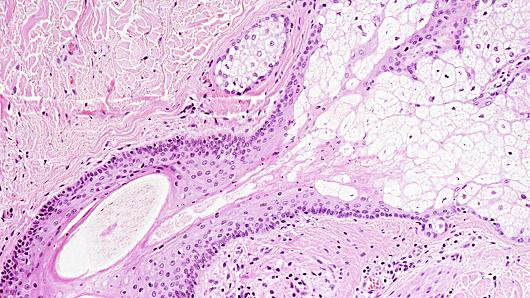Newly Discovered Organ May Aid In Cancer Diagnosis
A file photo of skin cells.
Modern research technology has led to the discovery of a long-misunderstood organ that could be full of answers to questions doctors have had for centuries.
The organ, known as the interstitium, is the largest organ in the body and is full of fluid that cushions organs. Scientists had a feeling such a structure existed for years but were unable to study it due to the limitations of previous medical tools. A new article in Scientific Reports is the first to classify the structure as an organ and explain how it works.
Neil Theise, a pathologist at New York University studying the interstitium, has found a potential link between the organ and the ways that certain types of cancer spread.
"It's a fluid cell highway," he explained. "When [cancerous cells] get into this layer, that's when they spread."
Cancerous cells attack the body by rapidly multiplying and are at their most deadly when they reach the lymph nodes. By this point, treatment becomes very difficult and chances of survival decrease. It's ideal to catch the mutated cells before they reach the lymph nodes, but some types of cancer, such as urinary cancer, are not possible to screen.
Theise hopes that if the cells are entering the bloodstream via the interstitium, they may leave a trace of protein in the fluid surrounding much of the body. Doctors can sample this fluid and test for cancerous cells before they reach the lymph nodes and become terminal.
Research on the interstitium still has a long way to go, but Theise believes that many answers lie in the research to come. The organ's structure and functionality may help researchers learn why certain cancers — such as skin, breast and stomach — spread and help doctors treat aggressive cancers.
The research may also help explain other medical mysteries, such as the effectiveness of acupuncture and where lymphatic fluid originates.
One Of The Deadliest Cancers Is On The Rise. Why?
While pancreatic cancer only accounts for about three percent of all cancers in the U.S., according to The American Cancer Society, it's often considered to be one of the deadliest.
Currently, pancreatic cancer stands as the third-leading cause of cancer death in America. However, a recent Scientific American article announced that pancreatic cancer is expected to pass colon cancer and assume the spot as the second-leading cause of cancer death in America this year.
Alarmingly, just five years ago, pancreatic cancer was only the fourth-leading cause of cancer death, demonstrating how quickly it's on the rise.
What's the cause behind these increased deaths from pancreatic cancer? The article suggests several reasons, and they're all not necessarily bad:
We're battling other cancers better: Screening and treatments for cancers like breast, prostate and colon cancer are allowing diagnosed patients to live longer and overcome their cancers.
We're using advanced testing: Improvement in testing biopsied tissue and utilizing high-resolution imaging has given us a way to identify tumors that couldn't be seen before. Unfortunately, some of them turn out to be pancreatic tumors.
We're living longer: The longer we live, the greater our chances of seeing genetic errors. More than three quarters of recently diagnosed pancreatic cancer patients have been identified as being between 55 and 84 years old.
This doesn't mean we're doing everything right, though.
Specifically, the article states one of the main reasons we're seeing an increase in pancreatic cancer deaths is because of the rise of obesity and type 2 diabetes – which are risk factors for the cancer. Additionally, smoking is a risk factor for pancreatic cancer. While smoking rates have been dropping, this doesn't mean they're still not a contributing factor.
Dr. Marc Mesleh, a hepatobiliary surgeon at Advocate Christ Medical Center in Oak Lawn, Ill. says, "Pancreatic cancer can be caused by a variety of reasons, including genetics, but some of the ways you can help reduce your risk is by not smoking, choosing a healthy diet and maintaining a healthy weight."
While Dr. Mesleh agrees that pancreatic cancer is an aggressive cancer that can be challenging to diagnosis because its symptoms are vague, he doesn't want people to be discouraged by this article.
Dr. Mesleh performs the Whipple Procedure, a procedure which only 30 to 50 percent of pancreatic cancer patients are eligible for, but wasn't always an option for pancreatic cancer patients, and can help extend life and increase five-year survival rates.
"While surgery for pancreatic cancer is complex, complication rates are much lower than they used to be. Especially when surgery is performed in a high-volume center. Despite what the article says, overall survival for pancreatic cancer is continuing to improve due to increased research resulting in additional treatment options focusing on optimal patient outcomes."
When diagnosed early, Dr. Mesleh says chances of surviving five years or more increases tenfold. While symptoms of pancreatic cancer can often be nonspecific, here's what he says you want to look out for: Yellowing of eyes and skin, darkening of the urine, upper abdominal pain, nausea, weight loss, diarrhea and new onset of diabetes.
For information about expert liver and pancreatic cancer care, click here.
Get the Chicago newsletterSubscribe
Thanks for your feedback.